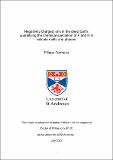Files in this item
Negatively charged ions in the deep Earth : quantifying the chemical speciation of F and N in silicate melts and phases
Item metadata
| dc.contributor.advisor | Mikhail, Sami | |
| dc.contributor.advisor | Ashbrook, Sharon E. | |
| dc.contributor.advisor | Mare, Eleanor | |
| dc.contributor.advisor | Dawson, Daniel M. | |
| dc.contributor.author | Formoso, Filippo | |
| dc.coverage.spatial | 297 | en_US |
| dc.date.accessioned | 2023-02-06T09:44:51Z | |
| dc.date.available | 2023-02-06T09:44:51Z | |
| dc.date.issued | 2022-11-29 | |
| dc.identifier.uri | https://hdl.handle.net/10023/26905 | |
| dc.description.abstract | Nitrogen and fluorine are essential volatile elements to study in the bulk silicate Earth (BSE) due to their respective influence over the onset of habitability on Earth or over physical and chemical properties of the phases which contain them. Nitrogen is abnormally depleted in the BSE relative to CI chondrite, while fluorine is abnormally enriched, hence questions arise about their chemical speciation and storage mechanisms within planetary reservoirs. The speciation of nitrogen in high pressure silicate melts was studied using solid-state nuclear magnetic resonance (NMR) and Raman spectroscopy and was found to be heavily influenced by oxygen fugacity. The former technique provided superior results in quantifying the abundance of individual species and higher sensitivity, however it requires ¹⁵N enrichment, low-Fe samples and performs only bulk analysis, while the latter was found to be an efficient in situ technique regardless of sample composition, but it struggled at detecting low-abundance N species. The speciation of fluorine in silicate melts was studied via NMR spectroscopy at BSE-like concentrations, thanks to this techniques high F sensitivity. F was found to be binding solely with Mg at atmospheric pressure, and this speciation remains predominant until c.a. 8 GPa, where relevant quantities of F start binding with Ca. This is likely due to the changing coordination number of the major components of the melt, but a change in the coordination of fluorine itself might also be occurring. The ordering of fluoride and hydroxide in the framework of humite group minerals was studied via NMR spectroscopy and computational modelling. The incorporation of one F and one OH anion in neighbouring sites was found to be favoured relative to the incorporation of two identical ions, thanks to the formation of a hydrogen bond. This likely explains the extended stability field of clinohumite when it is F rich. | en_US |
| dc.language.iso | en | en_US |
| dc.relation | Negatively charged ions in the deep Earth: quantifying the chemical speciation of F and N in silicate melts and phases (thesis data) Formoso, F., University of St Andrews, 7 Nov 2022. DOI: https://doi.org/10.17630/69a1bbd5-b1ab-4d85-b56e-80d5eb89d641 | en |
| dc.relation.uri | https://doi.org/10.17630/69a1bbd5-b1ab-4d85-b56e-80d5eb89d641 | |
| dc.rights | Creative Commons Attribution-NoDerivatives 4.0 International | * |
| dc.rights.uri | http://creativecommons.org/licenses/by-nd/4.0/ | * |
| dc.title | Negatively charged ions in the deep Earth : quantifying the chemical speciation of F and N in silicate melts and phases | en_US |
| dc.type | Thesis | en_US |
| dc.contributor.sponsor | University of St Andrews. School of Earth & Environmental Sciences | en_US |
| dc.contributor.sponsor | University of St Andrews. School of Chemistry | en_US |
| dc.contributor.sponsor | University of St Andrews. St Leonard's College | en_US |
| dc.type.qualificationlevel | Doctoral | en_US |
| dc.type.qualificationname | PhD Doctor of Philosophy | en_US |
| dc.publisher.institution | The University of St Andrews | en_US |
| dc.identifier.doi | https://doi.org/10.17630/sta/260 |
The following licence files are associated with this item:
This item appears in the following Collection(s)
Except where otherwise noted within the work, this item's licence for re-use is described as Creative Commons Attribution-NoDerivatives 4.0 International
Items in the St Andrews Research Repository are protected by copyright, with all rights reserved, unless otherwise indicated.


